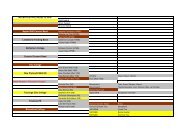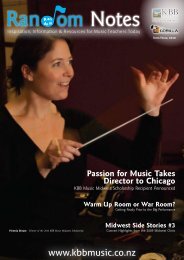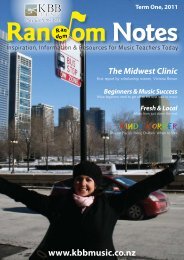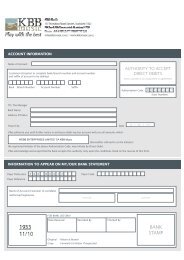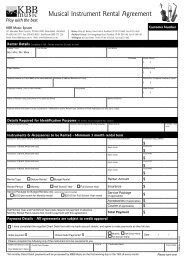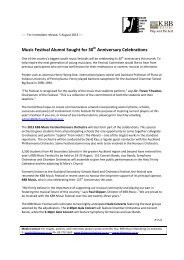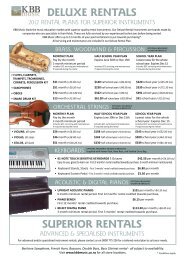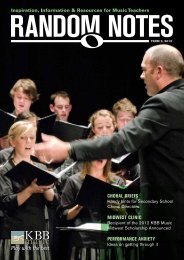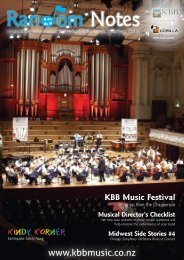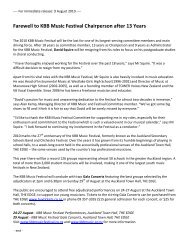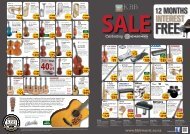ukulele teaching tips midwest clinic dealing with the voice - KBB Music
ukulele teaching tips midwest clinic dealing with the voice - KBB Music
ukulele teaching tips midwest clinic dealing with the voice - KBB Music
Create successful ePaper yourself
Turn your PDF publications into a flip-book with our unique Google optimized e-Paper software.
Tips for Teaching<br />
Ukulele to Older Beginners<br />
By Maria Winder, music consultant, The Sound of <strong>Music</strong> Education<br />
& Trustee of NZ Ukulele Trust<br />
The <strong>ukulele</strong> is a happiness machine, a weapon of massed affection.<br />
It encourages people to sing and it’s so easy to play and teach.<br />
TUNE-UP<br />
Always start <strong>with</strong> tuned <strong>ukulele</strong>s. You’ll have a better time<br />
playing and singing! Right from <strong>the</strong> first lesson, encourage<br />
your students to listen to and play <strong>the</strong> open strings G C E A,<br />
sing My Dog Has Fleas, so-do-me-la, 5-1-3-6, or create o<strong>the</strong>r<br />
phrases <strong>with</strong> <strong>the</strong> note letter names e.g. Give Compliments<br />
Every Afternoon. Encourage students to identify if a string is<br />
flat or sharp.<br />
STRUM A ONE-CHORD SONG<br />
Strumming can be as simple as playing <strong>the</strong> down<br />
beat <strong>with</strong> your thumb or index finger. Keep your<br />
wrist floppy and relaxed as you strum. The wellknown<br />
song “We Will Rock You” by Queen can be<br />
played <strong>with</strong> just one chord.<br />
Learn a more interesting rhythm for “We Will Rock You” using<br />
this speech pattern as you strum: down-down-chk-rest.<br />
GET READY TO CHANGE CHORDS<br />
This works well as a warm-up activity. The leader plays <strong>the</strong><br />
chord changes and <strong>the</strong> class responds <strong>with</strong> body percussion.<br />
2-chord song: pat your legs for chord I and pat your head for<br />
chord V i.e. pat legs for C and pat head for G7.<br />
3-chord song: pat legs for chord<br />
I, shoulders for chord IV and head<br />
for chord V i.e. pat legs for C,<br />
shoulders for F and head for G7.<br />
Kiwileles rehearsing at East Tamaki School<br />
PLAY A REPEATED SEqUENCE OF CHORDS<br />
It’s amazing how many songs use <strong>the</strong> same chord sequence.<br />
Repeat this 12 bar blues sequence, ending on chord C.<br />
C C C C F F C C<br />
G7 G7 F F C C G7 G7<br />
N.B. Bill Sevesi (<strong>the</strong> inspiration behind NZ’s <strong>ukulele</strong> revival and Patron of NZ Ukulele<br />
Trust) uses <strong>the</strong> above format when <strong>teaching</strong> children about chord changes.<br />
The 12 bar blues is one of <strong>the</strong> favourites in <strong>the</strong> NZ Ukulele<br />
Kiwileles repertoire.<br />
For details on how your school can get involved in <strong>the</strong> 2012<br />
Kiwileles, see <strong>the</strong> NZ Ukulele Trust website<br />
www.nz<strong>ukulele</strong>festival.org.nz or email Maria Winder<br />
maria@<strong>the</strong>soundofmusic.co.nz Maria coordinates <strong>the</strong> massed<br />
Kiwileles Orchestra for NZ Ukulele Trust.<br />
The 2012 NZ Ukulele Festival will be held on<br />
Saturday 1 st December at The Trusts Stadium, Waitakere.<br />
6 Random Notes <strong>Music</strong>al Instrument Specialists since 1888



